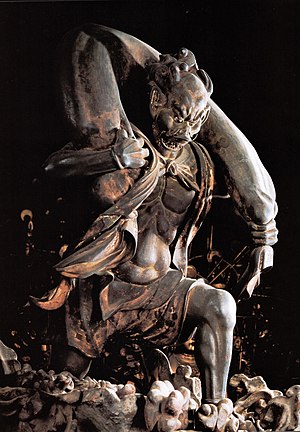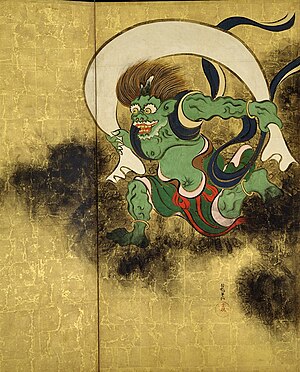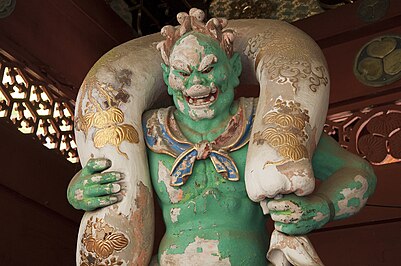Fūjin
This article needs additional citations for verification. (April 2018) |

Kamakura period, 13th century
Fūjin (風神, lit. "Wind God") or Fūten (風天, lit. "Heavenly Wind"), sometimes also known as Ryobu, is the Japanese god of the wind and one of the eldest Shinto gods.[1][2] He is portrayed as a terrifying wizardly demon, resembling a red-haired, green-skinned humanoid wearing a tiger or leopard skin loincloth/kilt, carrying a large bag of winds (風袋; Kazebuko/Fūtai) on his shoulders. In Japanese art, the deity is often depicted together with Raijin, the god of lightning, thunder and storms.
Myths
[edit]
This section needs expansion. You can help by adding to it. (April 2018) |
Birth
[edit]According to Kojiki, Fūjin and his brother Raijin were born from Izanami after she died.
When Izanagi went down to Yomi to retrieve his wife, he saw her as a decaying corpse covered with demons. Izanagi rejected her, making Izanami furious, leading her and a few monsters to chase after Izanagi. Izanagi then blocked the entrance to Yomi. However, a few demons and oni escaped the underworld through a crack in the boulder, including Fūjin and his brother Raijin.[3]
Depiction
[edit]
The iconography of Fūjin seems to have its origin in the cultural exchanges along the Silk Road. Starting with the Hellenistic period when Greece occupied parts of Central Asia and India, the Greek wind god Boreas became the god Wardo/Oado in Bactrian Greco-Buddhist art, then a wind deity in China (as seen frescoes of the Tarim Basin; usually named Feng Bo/Feng Po - "Uncle Wind" - among various other names), and finally the Japanese Wind God Fūjin. The wind god kept its symbol, the windbag, and its disheveled appearance throughout this evolution.

Left: Greek wind God (Greco-Buddhist art of Gandhara), Hadda, 2nd century.
Middle: Wind God from Kizil, Tarim Basin, 7th century.
Right: Japanese Wind God Fujin, 17th century.
See also
[edit]- Aeolus (Odyssey)
- Rudra, the Vedic wind or storm God
- Vayu, Hindu god of wind
References
[edit]- ^ Roberts, Jeremy (2009). Japanese Mythology A to Z. Infobase Publishing. ISBN 978-1-4381-2802-3.
- ^ "Some Similar and Parallel Points Between the Turkic Legendary "Creation" and Similar Texts of Japan". Folklor/Edebiyat. 20 (77): 189–196. 2014. ISSN 1300-7491.
- ^ "Fujin – Mythopedia".
Bibliography
[edit]- Boardman, John (1994). The Diffusion of Classical Art in Antiquity. Princeton, NJ: Princeton University Press. ISBN 0-691-03680-2.
- Tokyo Kokuritsu Hakubutsukan; Hyogo Kenritsu Bijutsukan (2003). Alexander the Great : East-West cultural contacts from Greece to Japan. Tokyo: Tokyo Kokuritsu Hakubutsukan. OCLC 53886263.
{{cite book}}: CS1 maint: multiple names: authors list (link) - Bopearachchi, Osmund (2003). De l'Indus à l'Oxus, Archéologie de l'Asie Centrale (in French). Lattes: Association imago-musée de Lattes. ISBN 2-9516679-2-2.
- Errington, Elizabeth; Joe Cribb; Maggie Claringbull; Ancient India and Iran Trust; Fitzwilliam Museum (1992). The Crossroads of Asia : transformation in image and symbol in the art of ancient Afghanistan and Pakistan. Cambridge: Ancient India and Iran Trust. ISBN 0-9518399-1-8.
Notes
[edit]- ^ "The Japanese wind god images do not belong to a separate tradition apart from that of their Western counter-parts but share the same origins. ... One of the characteristics of these Far Eastern wind god images is the wind bag held by this god with both hands, the origin of which can be traced back to the shawl or mantle worn by Boreas/ Oado." (Katsumi Tanabe, "Alexander the Great, East-West cultural contacts from Greece to Japan", p21)
Lua error in Module:Navbox at line 535: attempt to get length of local 'arg' (a number value).
